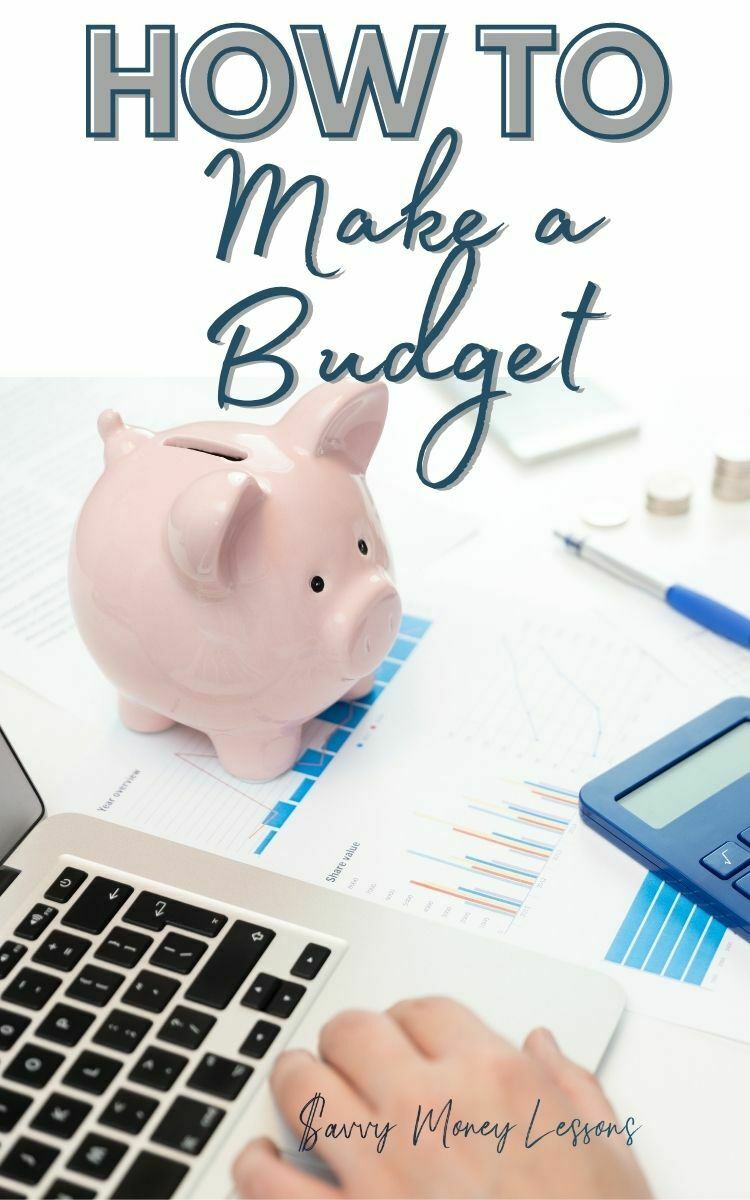How to Make a Budget in 5 Easy Steps
This post may contain affiliate links, which means I may earn a small commission if you click and make a purchase. You can read our full disclosure policy here.
Last Updated on August 20, 2024 by Rebecca
Struggling with how to make a budget?
A budget is a plan for spending money each month. When you have a budget in place, it’s much easier to work toward saving, paying down debt and other financial goals.
Making a budget allows you to see what you have coming in and what money goes out each month. While it’s not the most exciting way to spend an afternoon or evening, budgeting is something most people need to do in order to take control of their money.
Ready to learn how to make a budget and stick to it? Keep reading to learn the best way to budget, step by step.

Want free money?
Check out my favorite apps for making extra money and earning cash back!
Survey Junkie. Earn up to $50 per survey for sharing your opinions
Swagbucks. Make money playing games and watching videos ($5 bonus!)
InboxDollars. Take surveys and get paid for your opinions
Rakuten. Earn up to 40% cash back, plus get $30 for each person you refer
CashApp. Get $5 free when you use code ‘VZXRXZN’ to join CashApp
Writers Work. Earn extra cash from your writing skills!
What Is a Budget?
A budget is a plan for spending your income each month. Your budget is your personal roadmap for making the most of the money that you have.
There are different ways to budget money. Some of the most popular budget methods include:
- Dave Ramsey budgeting
- 50 30 20 budgeting
- 30 30 30 10 budgeting
- Zero-based budgeting
- 70 20 10 budgeting
- Paycheck budgeting
- 10 10 80 budget method
- Cash envelope budgeting
Pro tip: Struggling to stay on top of expenses? Consider using a personal finance tool like Empower to track all of your financial accounts in one place.

Why Is Budgeting Important?
The simple answer is that having a budget in place can help you make smarter decisions with your money. When you have a realistic budget, it’s easier to:
- Avoid overspending or running up debt on credit cards
- Plan out your expenses and keep track of when bills are due
- Set savings goals and work toward them consistently
- Create a vision for your long-term financial goals
Budgeting is pretty boring when you think about what’s actually involved. But budgeting can be a powerful tool for managing your money and living your best life financially.
How to Make a Budget in 5 Easy Steps
Making a family budget doesn’t have to be difficult or intimidating. If you’re ready to make your first budget, plan to block off an afternoon to get organized.
It’s a good idea to round up:
- Copies of your bills
- Pay stubs or other income statements
- Bank statements for the past month
- A calculator
- A budget planner, notebook or Excel spreadsheet
If you’ve got your paperwork together, here’s what you’ll need to do next to make a budget.

Ready to get your budget together?
Grab our monthly budget worksheet, spending tracker and debt repayment tracker when you join the Savvy Money Lessons email list!
1. Calculate your income
The first step in how to make a budget is to know how much income you have to work with. So make a list of all the income you receive each month, including income from:
- Your 9 to 5 job
- Part-time jobs
- Side hustles or self-employment
- Government benefits (like Social Security payments)
- Investments (including dividends or rental property income)
- Child support or alimony payments you receive
Anything that comes in steadily every month would be considered income for your budget.
Pro tip: If you have irregular income, add it up for the past 12 months then divide by 12 to get a baseline average.
2. Figure out your monthly expenses
Once you have your income amount, the next step is to create a list of your monthly expenses. Your expenses are what will come out of your bank account each month.
There are three basic categories of expenses to include when making a budget:
- Fixed expenses. These are expenses that don’t change from month to month, like your mortgage or rent payments.
- Variable expenses. These expenses recur monthly but may not always be the same amount. Utility bills are a good example of fixed expenses.
- Discretionary expenses. Discretionary expenses are things you spend money on but don’t necessarily need to maintain your basic standard of living. These are the “wants” in your budget.
You could also create additional budget categories for taxes, debt repayment and savings.
It’s important to include everything you spend money on when making a budget. Otherwise, your spending plan may not be realistic and you could end up with an unexpected shortfall.
Here are a few examples of monthly expenses to include in a budget:
- Monthly car payment(s)
- Mortgage payments or rent
- Childcare costs
- School fees or extracurricular activity fees
- Personal care
- Transportation costs
- Insurance (car insurance, renter’s insurance, life insurance, etc.)
- Utilities, including electric and water bills
- Phone and internet bills
- Groceries
- Household expenses, like cleaning supplies
- Pet care expenses
- Loan or credit card payments
Looking at your previous bills can help you estimate what amount you will need to budget for those each month. For example, you might review your utility bills for the last year to see what you typically pay month to month.
Once you have everything together, total up your expenses for each budget category. Then, add up all of your expenses to get one grand total.
Pro tip: Budgeting isn’t just for teens and families. Even younger kids can try making a needs/want budget of their own to learn basic money skills!
3. Subtract expenses from income
The next step in how to make a budget is the easiest. Here, you’ll just subtract your expenses from your income.
- If you have money left over after expenses are paid, then you’re already ahead of the game.
- If you have more expenses than income, then you’ll need to rethink where your money is going.
The goal is to have more income than expenses so that you can create a healthy budget. A good budget allows you to pay all your expenses while also giving you some extra wiggle room to save for a rainy day.
Having an emergency fund is a must-have so that you don’t have to worry about charging unexpected expenses to a credit card with a steep APR. Roughly a quarter of Americans don’t have an emergency fund and you don’t want to be in that group in case a crisis comes along.
4. Trim the fat in your budget
If you’ve done the math and you know what you’re spending relative to what you’re earning, you can take a closer look at your budget plan.
The goal is to weed out unnecessary expenses, then redirect that money to savings, debt repayment or another goal.
For example, some of the things you might be able to cut from your budget include:
- Unused subscriptions or streaming services
- Take-out food
- Gym memberships
- Impulse purchases
- High bank fees
- Cable TV, internet or cell phone add-ons that you don’t really need or use
If you’re not sure where to make cuts in your budget, you can use a tool like Trim.
Trim is a financial manager that reviews your spending habits and finds extra money to save. It’s a simple way to put money back into your budget, without a lot of hard work.
Start using Trim to save money on bills!
5. Decide what to do with leftover money
If you’ve gone over your budget and cut out wasteful spending, the final step is figuring out what to do with the extra. Having a family financial plan can help you make the most of it.
Some of the best ways to use the extra money in your budget include:
- Building an emergency fund
- Paying down high-interest credit card debts
- Making extra payments to your student loans or mortgage
- Funding a retirement account
- Investing in stocks for passive income
- Saving money for your kids’ college needs
- Adding money to sinking funds
You could also use the extra money you have to get a month or more ahead on bills. That way, you don’t have to stress about making sure the bills get paid on time.
Bonus tip: Review your budget regularly
A budget is not something you make once and forget about. Instead, it’s important to check in with your budget regularly to make sure your spending is still on track. Scheduling a weekly or monthly budget review can be a simple and effective way to stay on top of your finances.
Recommended Budget Planners
It’s good to set your budget and the best way to monitor it is to use a budget planner. Budget binders or planners are perfect for listing your income and expenses to keep track of your budget each month.
These budget planners are a great way to stay on track with your finances. Since everyone likes to track their finances in their own way, this is where planners come into play! They’re an easy way to write out and keep track of your monthly money plans.
Final thoughts on how to make a budget
Budgeting can seem tedious but if you want to become financially stable, it’s not something you can afford to skip. Learning how to make a budget isn’t that difficult. The real challenge is figuring out how to stick to your budget so you can get closer to your money goals.
Need more money tips? Read these posts next:
- 6 Ways to Save Money on Kids’ Toys
- How to Save Money While Traveling
- Best Ways to Save Money Right Now
- 8 Ways to Save Money on Groceries
Are you ready to learn how to make a budget?
About the Author
Rebecca is a certified educator in personal finance (CEPF) and a money-saving expert. As a single mom of two teens, she knows all about the importance of family budgeting and financial goal-setting. She shares her best tips about saving and managing money at Savvy Money Lessons. You can also read her work online at Bankrate, Forbes Advisor, Investopedia and other top publications. Learn more









![70 20 10 Budget Rule [How 70-20-10 Budgeting Works]](https://savvymoneylessons.com/wp-content/uploads/2023/06/30-30-30-10-Budget-2-640x1024.png)
![100 Envelope Challenge Chart [Free Printable Savings Tracker!]](https://savvymoneylessons.com/wp-content/uploads/2022/04/Savvy-Money-Lessons-Pins-640x1024.jpg)

![Importance of a Family Budget and How to Make One [2023]](https://savvymoneylessons.com/wp-content/uploads/2023/02/Jobs-for-10-Year-Olds-to-Make-Money-640x1024.jpg)

9 Comments